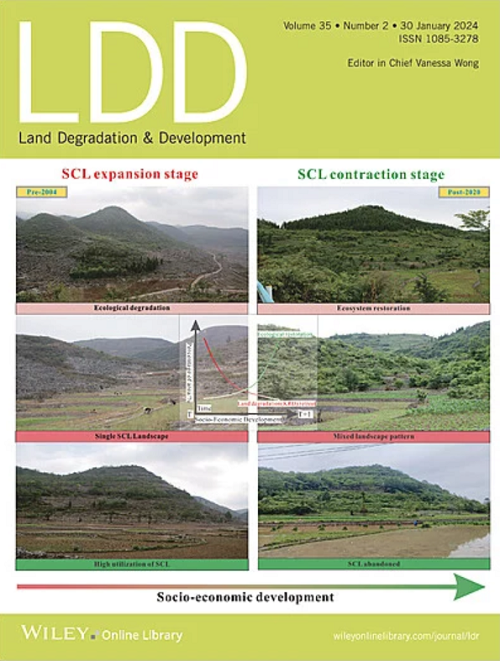主要道路网络对特赫里地区景观和生长格局的影响:地理空间技术
IF 3.7
2区 农林科学
Q2 ENVIRONMENTAL SCIENCES
引用次数: 0
摘要
本研究通过分析建成区的空间分散格局,利用香农熵指数(H)作为城市可持续增长的指标,考察了2000 - 2024年特赫里地区土地利用和土地覆盖(LULC)的变化。使用最大似然分类器将2000年、2010年、2020年和2024年的陆地卫星图像分为荒地、建成区、森林和水体。2000年,荒地占53.23%,其次是森林占42.54%,建成区占3.75%,水体占0.48%。到2024年,森林面积扩大到51.67%,荒地面积减少到33.16%,建成区面积显著增加到14.55%,水体面积小幅增加到0.63%。Shannon熵指数的计算基于城市中心和主要道路网络的接近程度,将研究区域划分为区域。结果表明:2024年,城市中心(HC’)和主干道(HR’)的归一化香农熵指数(Shannon Entropy Index)分别为0.978和0.58,反映出城市碎片化程度的加剧;8区和16区空间离散度最高(0.96),表现出不规则的发展格局和向外扩张的趋势。2000年,Tehri地区被划分为d类。多年来,它大多转向B类,表现出更分散和可能不可持续的增长。我们提倡将城市中心与城市周边地区相结合的综合空间利用控制策略。本研究证明了香农熵指数在确定丘陵地区潜在的不可持续发展区方面的效用,并为具有类似地形和发展动态的其他地区提供了一个可复制的框架。本文章由计算机程序翻译,如有差异,请以英文原文为准。
Impact of Major Road Network on Landscape and Growth Pattern in Tehri Region: A Geospatial Technique
This study examines land use and land cover (LULC) changes in the Tehri region from 2000 to 2024, utilizing the Shannon Entropy Index (H) as an indicator of sustainable urban growth by analyzing spatial dispersion patterns of built‐up areas. Landsat imagery from 2000, 2010, 2020, and 2024 was classified into barren land, built‐up areas, forest areas, and water bodies using the Maximum Likelihood Classifier. In 2000, barren land dominated with 53.23%, followed by forests at 42.54%, built‐up areas at 3.75%, and water bodies at 0.48%. By 2024, forests expanded to 51.67%, barren land decreased to 33.16%, built‐up areas grew significantly to 14.55%, and water bodies increased slightly to 0.63%. The Shannon Entropy Index was calculated based on proximity to the city center and major road networks, dividing the study area into zones. Results reveal a rising normalized Shannon Entropy Index for the city center (HC ′) and main road (HR ′), with values of 0.978 and 0.58 in 2024, reflecting increased urban fragmentation. Zones 8 and 16 exhibited the highest spatial dispersion (0.96), indicating irregular development patterns and outward expansion. In 2000, the Tehri region was classified as type D. Over the years, it has mostly shifted to type B, showing more dispersed and possibly unsustainable growth. We advocate for a comprehensive space utilization control strategy that integrates the city center and the peri‐urban area. This research demonstrates the utility of the Shannon Entropy Index in identifying potential zones of unsustainable development in hilly regions and offers a replicable framework for other areas with similar topographical and developmental dynamics.
求助全文
通过发布文献求助,成功后即可免费获取论文全文。
去求助
来源期刊

Land Degradation & Development
农林科学-环境科学
CiteScore
7.70
自引率
8.50%
发文量
379
审稿时长
5.5 months
期刊介绍:
Land Degradation & Development is an international journal which seeks to promote rational study of the recognition, monitoring, control and rehabilitation of degradation in terrestrial environments. The journal focuses on:
- what land degradation is;
- what causes land degradation;
- the impacts of land degradation
- the scale of land degradation;
- the history, current status or future trends of land degradation;
- avoidance, mitigation and control of land degradation;
- remedial actions to rehabilitate or restore degraded land;
- sustainable land management.
 求助内容:
求助内容: 应助结果提醒方式:
应助结果提醒方式:


